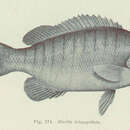Life Cycle
provided by Fishbase
Maturing luderick form large aggregations. Mature fish undertake 'runs' from inside the rivers and coastal lakes to the sea. The fish spawn in the surf zone and estuary mouths (Ref. 6390).
Trophic Strategy
provided by Fishbase
Larvae inhabit seagrass beds, moving out of them into mangrove-lined creeks and estuaries during their first year (Ref. 6390).Luderick are moderately sedentary, schooling fish. They do however, move between and within estuaries and coastal lakes, with a more pronounced movement or migration occurring prior to spawning (Ref. 5962, 28604, 28605). They are daytime foragers which rove about in large groups browsing over algal beds in shallow water (Ref. 26966).
Biology
provided by Fishbase
Adults favor estuarine (including mangroves), rocky reef and inshore, coastal water habitats (Ref. 5962, 27248). They flourish in seagrass areas (Ref. 6390). Ludericks are moderately sedentary, schooling fish. They are herbivorous and feed primarily on seagrasses (Ref. 6390). Filamentous algae (Ref. 26966) and cabbage weed also form part of their diet (Ref. 28607). Marketed as fresh fish (Ref. 10384).
- Recorder
- Crispina B. Binohlan
Importance
provided by Fishbase
fisheries: commercial; gamefish: yes
- Recorder
- Crispina B. Binohlan

